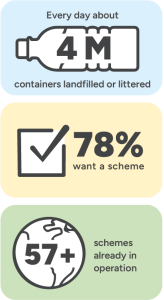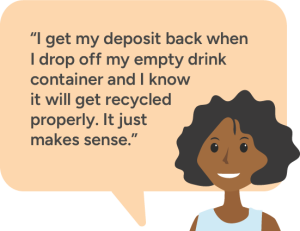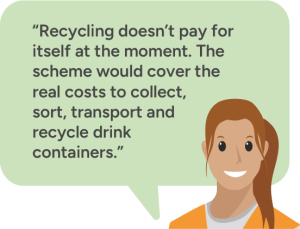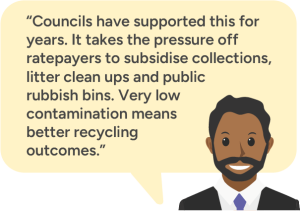A container deposit return scheme for New Zealand
A container deposit return scheme is a practical, cost effective way to help New Zealanders reduce litter, waste less and recycle more. Schemes are already being used in 57 countries and states to collect drink containers and cover the real cost of recycling. Surveys show 80% of New Zealanders want a container deposit return scheme here. Many fondly remember returning bottles to claim deposits in the 1970s and 1980s.
Resources
Download briefing PDF here
Factsheets
- Key features of well-designed container deposit return schemes – read here
- Driving performance: Effective deposit and a broad scope – read here
Webinar recordings
Webinar: Container Returns – targets, checks and balances – watch here
Reloop Resources – June 2025
Fact Sheet: Before and after: How deposit return systems cut beverage container litter
Full Report: Littered with evidence Proof that deposit return systems work
What is a container deposit return scheme?
A container deposit return scheme would set up the systems New Zealand needs to achieve high recycling rates and cut waste. It is a practical way to fix inherited problems with recycling and reduce litter.
- Consumers pay a deposit (like 20c) when they buy a drink in a bottle, can or carton, which they get back when they return their empty container. Anyone can claim the deposit if they find littered bottles and cans which reduces litter and pollution.
- Overseas schemes achieve high collection rates for drink bottles, cans and cartons with almost no costly contamination. European schemes average 87% return rates, with some achieving 95%.
- Drink producers also contribute a few cents per container to cover the real cost of recycling including collections, transport and logistics. This makes drink producers look good to their customers and takes the pressure off councils and ratepayers to subsidise kerbside recycling and public bins for drink containers.
Next steps for New Zealand
Where the previous Government fell short, this Government has an opportunity to implement a popular and tangible, low-cost policy. The development work has already been done, the design is based on international best practice and is a good fit for New Zealand. With the revision of the Waste Minimisation Act 2008 well underway, the regulatory framework is primed for an effective deposit return scheme.
Benefits of a container deposit return scheme for New Zealand

Every day about 4 million drink bottles, cans and cartons get landfilled or littered in New Zealand. A well-designed container deposit return scheme would set up the system we need to achieve high recycling rates and cut waste, litter and emissions. It would take the pressure off ratepayers and councils and create a more viable and stable recycling industry.
Container deposit return schemes are already popular with the New Zealand public who remember returning bottles in the 1970s. Tourists and kiwi travellers return bottles and cans when overseas, so they know how schemes work.
A 2022 survey by Reloop showed 78% of New Zealanders want a scheme here for drink bottles, cans and cartons. 98% of the submissions received in the 2022 public consultation supported the government establishing a scheme.
57 countries and states already run container deposit return schemes across Europe, USA, Canada, Australia, Asia and Africa. 14 more are setting schemes up to recycle more and cover the real cost of recycling. New Zealand is becoming an outlier with low collection and recycling rates, which is a risk to our reputation as a clean, green tourist destination and exporter.
A well-designed container deposit return scheme will:
- Double the collection rate for bottles, cans and cartons from 45% to 90%.
- Reduce litter on our beaches, roadsides, parks and rivers by 60%.
- Reduce greenhouse gas emissions across the beverage supply chain by replacing virgin content in drink packaging with recycled glass and plastic
2.6 billion drink bottles, cans and cartons get sold in New Zealand each year. Less than half of these are collected for recycling. A container deposit return scheme is a cost effective, practical way to fix inherited problems with our recycling systems and safeguard New Zealand’s clean, green brand.
Economic Benefits
- As a user pays scheme, the costs fall more fairly on those that produce and consume drinks, which takes pressure off councils and ratepayers.
- Lower cost for litter clean ups, emptying public rubbish and recycling bins, kerbside collections and landfilling which saves communities money. and bottle reuse.
- Attract investment to help establish the systems required for high quality recycling.
- Create new jobs and value-add opportunities in the reuse and recycling industry and new fundraising opportunities for clubs and community groups.



Key features of a container deposit return scheme for New Zealand
A well-designed container deposit return scheme will achieve recovery rates of 85% or more. With the right policy settings in place it is easy to set up and run a successful scheme. International experience shows that high-performing schemes are based on a combination of interconnected features which means they are convenient, easy to understand and have practical targets, checks and balances. A modern, fit-for–purpose scheme needs to include these features at the outset.
A successful container deposit return scheme is convenient, performs well, and has practical targets, checks and balances:
- It needs to be convenient for everyone, which means a mix of return locations:
a. A network of local drop off sites that builds on the existing recycling and resource recovery system.
b. Shops that sell drinks, like supermarkets, provide return points where people can take back their empty bottles, cans and cartons across the country (return-to-retail). - To perform well, it needs an effective deposit and a broad scope of drink containers, which for New Zealand would be:
a. A 20 cent refundable deposit, which is a high enough incentive for people to return drink containers, and pick them up when they’ve been littered, to claim the refund.
b. The scope of drink containers is comprehensive, including glass and plastic bottles, metal cans and beverage cartons, for recycling or reuse. - It needs practical targets, checks and balances:
a. Return rate targets of 85% from year 3, and 90% from year 5, ensuring high performance and value for money for New Zealanders, with consequences if the targets are missed.
b, A user-pays system in which beverage producers pay the deposit on each container they sell, regardless of whether the container is returned for the refund. This producer responsibility takes the pressure of ratepayers and councils, and unredeemed deposits help fund the scheme.
It is the combination of these features – convenience, performance, and practical targets, checks and balances – that will make a successful container deposit return scheme. A modern, fit-for–purpose scheme needs to include these features at the outset.
The container return scheme already drafted by MfE includes this combination of features, based on international best practice, and is a good fit for New Zealand.
Supporting evidence for a container deposit return scheme for New Zealand
Container deposit return schemes are practical, cost-effective and popular systems for collecting, reusing and recycling drink bottles, cans and cartons. A well-designed scheme would collect 90% of the 2.6 billion drink containers that get sold here each year. Establishing a scheme in New Zealand is an achievable goal.
They work
Container deposit return schemes achieve 90% collection rates, deliver high quality recycling and cut waste and litter. By 2027, schemes will be running in 71 countries and states, 57 already run schemes and 14 are setting them up. Australia has 6 schemes operating with Tasmania setting one up. The European Union has set 90% collection targets for drink containers and Member States that miss the target have to set up a container deposit return scheme. See Reloop’s Global Deposit Book 2024 for details.
They are popular
A Kantar 2023 survey found that a container return scheme is very appealing to New Zealand consumers, with positive support from 89% of respondents. Surveys show 78% of New Zealanders want a scheme established here (Reloop 2022). 98% of the responses to the 2022 public consultation asked the Government to establish a scheme (MfE 2023). In 2018 Local Government New Zealand passed a remit to establish CDRS, with 96% of Mayors in favour (LGNZ 2018). The majority of WasteMINZ members support the introduction of a container deposit return scheme model as soon as possible (WasteMINZ Government Briefing 2023).
They pay for themselves
The real costs of recycling are built into the purchase price of the drink, which takes the pressure off ratepayers and local councils who currently subsidise drink container recycling. Drink producers pay a few cents per container to cover the cost. The Cost Benefit Analysis supporting the proposed container deposit return scheme model projected a net-benefit of $1.135 billion over 30 years – a Benefit Cost Ratio of 1.48 – showing that benefits outweigh costs by almost 50% (Sapere, 2022).
The development work has been done
A proposed container deposit return scheme design has already been developed. This scheme is based on international best practice and is a good fit for New Zealand. The design and evaluation process included stakeholder engagement, input from technical experts, financial and cost benefit modelling, public consultation and thorough policy design. Work to date including design, analysis and cabinet papers here. The revision of the Waste Minimisation Act 2008 to update the regulatory framework and enable an effective deposit return scheme is well underway.



